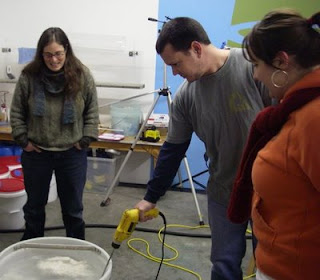


I'm pretty sure our work with plastic media will never end. I'll be 90 years old and still messing with the vagaries of color, cost, shape, density, and size. Though we've talked to a lot of sedimentologists, it just now occurred to me that we've opened an odd branch of that field all our own.
Others have looked at modeling fluvial process at small scales using non-lithic materials. The Army Corps has used coal. But we have to find a steady supply, thousands of pounds, at a reasonable price, and in colors that are aesthetically pleasing.
The only reasonably priced material, post industrially-recycled melamine, arrives at an abrasives supplier, usually, in small (<50mm) chunks, and hand sorting it for color isn't economically feasible. We're the only buyer who cares about color. So we work with our supplier(s) to get a color mix that has a fairly high chroma (brightness) that is pleasing to the eye. Our latest batch (photo shows one size fraction) took about a month to find. For some reason the surplus melamine market is flooded with red, and we've learned that too much red is hard on the eyes.
Today we worked on methods for washing the media; removing the dust left on it from grinding and shipping. Here Cara and Stephanie watch Jessie trying a new method we're working on. And then Jesse threatens Cara with a propeller mixer.Labels: army corps engineers, development, em2, em4, fun, LRRD team, modeling media, plastic media, sediment, sedimentology

